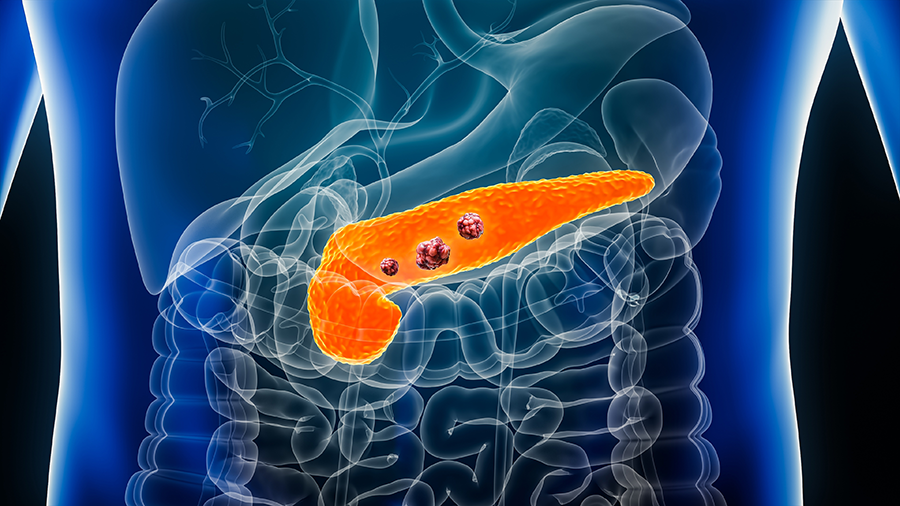Turning to AI, NIH Scientists Reveal Promising Pancreatic Cancer Drug Combinations
May 29, 2025
By using existing drugs in new ways, researchers are trying to beat a complex cancer that’s hard to detect and resists treatments.
An analytical tool designed by National Institutes of Health scientists and driven by artificial intelligence (AI) could point the way to new treatment options for pancreatic cancer. Using machine learning, researchers sifted through nearly 1.6 million potential drug and compound combinations to reveal more than 300 that showed synergy, meaning their combined effect is greater than each given alone. Their approach could have applications for many other cancers and diseases. The work appears in Nature Communications.
Pancreatic cancer is one of the deadliest cancers. Its overall five-year survival rate is about 13%. The poor outlook is due, in part, to both late detection and complex genetics. On average, pancreatic cancers can have as many as 63 genetic changes that can derail biological pathways and actions within pancreatic cells. Also, pancreatic cancer is hard to treat. Its most common form — pancreatic ductal adenocarcinoma — can adapt and find ways to resist treatment.
Fighting pancreatic cancer with a mix of drugs can help counter its genomic variation and drug resistance. To find drug combinations that work against pancreatic cancer, scientists at NIH’s National Center for Advancing Translational Sciences (NCATS) partnered with researchers at The University of North Carolina at Chapel Hill (UNC) and the Massachusetts Institute of Technology (MIT).
NCATS scientists led by Alexey Zakharov, Ph.D. started the study by using cell-based assays to screen 1,785 U.S. Food and Drug Administration-approved cancer drugs and potential anticancer compounds in an NCATS collection. They found 32 drugs and compounds that showed the most promise against pancreatic cancer cells in the laboratory. The NCATS team then examined 496 combinations of the 32 compounds in laboratory tests.
The NCATS, UNC and MIT teams then used the 496 combination results to develop the different machine learning (ML) models for a bigger job of determining more promising drug combinations. In all, 1,785 drugs can have nearly 1.6 million possible combinations — far too many to test by hand in the lab.
Each of the three teams used its developed ML models to predict the top 30 drug combinations from the 1.6 million, which are expected to have the strongest synergy. Even though the ML methods were similar, only two combinations overlapped in all three groups.
The NCATS researchers tested the synergy of the remaining 88 top-predicted combinations in pancreatic cancer cells from the developed ML models. They confirmed that roughly 60% of the drug combinations worked synergistically in cancer cells. In all, the teams found 307 drug combinations that had synergistic effects on the pancreatic cancer cells. Many combinations worked through different mechanisms.
“In the past, without AI, researchers were restricted in the combinations they could consider examining. We screened compounds and drugs prospectively. We didn’t rely on prediction results in the lab to discover active combinations,” Zakharov said. “We tried to go beyond those limitations in the lab. Using these or similar methods, researchers might be able to get new and more interesting combinations.”
Several combinations stood out. Two drugs, NSC-319726 and AZD-8055, showed synergies with several compounds, as well as with each other, highlighting their potential clinical effects. NSC-319726, which plays a role in turning on a mutant version of the p53 gene, is being studied as a likely treatment for pancreatic cancer. The gene helps control cell division and prevent cancer. Mutant p53 protein is important in driving pancreatic tumor growth, making it a key drug target. Similarly, AZD-8055, an mTOR inhibitor, is being studied for its potential role in treating various cancers, including pancreatic tumors. mTOR inhibitors like AZD-8055 target a key process involved in cancer cell growth and survival.
Zakharov said that the results highlight the value of ML models in predicting drug synergy. “Often times, compounds are inactive by themselves, but mixed together, they show synergy and effectiveness,” he said. “We found that the different mechanisms of action were a reason for the drug synergies in the combinations we discovered. We need to be able to better define those combinations and explain how they work together against the cancer.”
The researchers suggest the work could help quicken the pace of drug discovery, including drug repurposing.
“This study presents a scalable and generalizable pipeline that can accelerate the discovery of effective drug combinations — not only for pancreatic cancer, but for other diseases where single therapies often fall short,” said NCATS’ Sankalp Jain, Ph.D., co-first author of the study. “By prospectively validating hundreds of new synergistic combinations, we’ve demonstrated how AI-guided predictions integrated with quantitative high-throughput screening can meaningfully inform translational research and preclinical decision-making for otherwise treatment-resistant cancers.”
“AI and drug repurposing can open up so many possibilities. We’re increasingly beginning to see AI as a powerful tool in cancer drug development,” said Zakharov. “The bottom line will be how this plays out in the future, and if new drug combinations ultimately reach the clinic using these kinds of approaches.”
Related Content
Matrix Combination Screening
Our experts use matrix combination screening technology to quickly identify promising drug combinations with the most potential to help patients.
Automation
Our automation experts work closely with our lab scientists to support various research activities, including high-throughput screening, and assay development and optimization.
Compound Management
Our compound management team uses sophisticated and automated techniques to supply chemicals for NCATS screening experiments to uncover new treatments for diseases.



